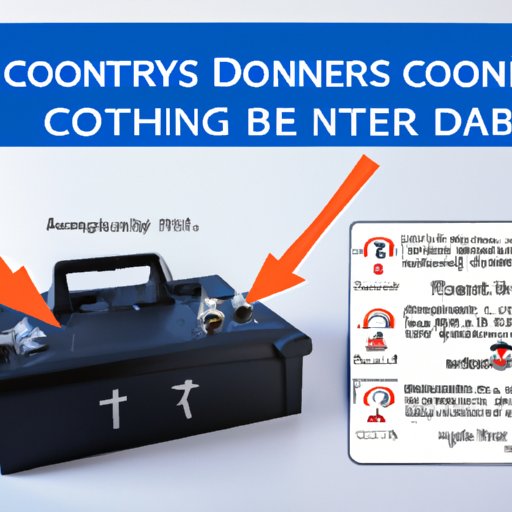Introduction
Knowing how to disconnect a car battery is an essential skill for any car owner. Whether you need to replace the battery, perform maintenance on the electrical system, or prevent battery drain when leaving your car unused for extended periods, disconnecting the battery is a straightforward procedure that requires minimal tools and experience. This article is intended to provide a comprehensive guide on how to safely disconnect a car battery, common mistakes to avoid, tips and tricks for making the process easier, reasons to disconnect, warnings and risks to keep in mind, and more.
Step-by-Step Guide
The following steps will guide you through the process of disconnecting a car battery:
- Start by turning off the engine and removing the key from the ignition. Make sure your car is on a level surface, and the parking brake is engaged.
- Locate the battery: In most cars, the battery is located under the hood, but it can also be in the trunk or under the back seat. Consult your user manual to find the exact location.
- Identify the positive and negative terminals: The positive terminal usually has a red or marked cap, and the negative terminal is black or unmarked.
- Put on gloves and eye protection: Batteries contain sulfuric acid, which can cause burns and damage to your eyes. Always wear gloves and eye protection before handling the battery.
- Disconnect the negative cable: Using a wrench or pliers, loosen the nut on the negative terminal and remove the cable from the battery. Wrap the cable end with electrical tape or a plastic bag to prevent accidental contact with metal parts and the battery terminal.
- Disconnect the positive cable: Repeat the same process for the positive terminal. Take care not to let the cable touch the negative terminal or any metal parts as this can cause sparks or short-circuiting.
- Remove the battery: With both cables disconnected, you can safely remove the battery from its compartment.
Remember to handle the battery with care, especially if it’s heavy or corroded. Place it on a stable surface and away from anything flammable or combustible.
Common Mistakes
Some common mistakes people make when disconnecting their car battery include:
- Removing the positive cable first: This can cause a spark or electrical surge that can damage the electrical system.
- Touching the metal parts or the battery terminal with the cable end or the tools: This can cause sparks, short-circuiting, or electrical shock.
- Not using gloves or eye protection: This can cause burns, eye damage, or clothing damage.
- Reversing the cable connections when reattaching the battery: This can cause damage to the electrical system, the battery, or the car.
To avoid these mistakes, always follow the correct sequence of disconnecting the negative cable first, use insulated tools, wear gloves and eye protection, label the cables before removing them, and consult your user manual if in doubt.
Tips and Tricks
Here are some tips and tricks to make disconnecting a car battery easier and safer:
- Use a battery terminal cleaner to remove any corrosion or debris from the terminals and the cables before disconnecting them.
- Label the cables with tape or a marker to remember which one goes where when reattaching them.
- Use a battery tender or trickle charger to keep the battery charged and maintained when not in use.
- Consider using a memory saver device or a scan tool to avoid losing your car’s settings and data when disconnecting the battery.
Reasons to Disconnect
There are several valid reasons why someone may want to disconnect their car battery:
- To replace the battery: If your battery is old, damaged, or not holding a charge, you may need to replace it.
- To prevent battery drain: If you’re leaving your car unused for an extended period, disconnecting the battery can prevent it from losing its charge and becoming dead.
- To perform electrical maintenance: If you need to work on your car’s electrical system, disconnecting the battery can prevent accidental shorts or electrical surges.
- To avoid accidental starting: If you’re working on the engine, transmission, or other parts of the car, disconnecting the battery can prevent the engine from starting accidentally and causing injury or damage.
Warnings and Risks
Disconnecting a car battery can be hazardous if not done correctly. Some risks and hazards to keep in mind include:
- Sulfuric acid can cause burns and damage to clothing or metal parts.
- Electrical surges or shorts can damage the electrical system or cause injury.
- Sparks or flames can cause fires or explosions if there’s fuel leakage or flammable material nearby.
- Reversing the cable connections when reattaching the battery can cause damage to the electrical system or the car’s computer.
Always take precautions to minimize these risks, such as wearing gloves and eye protection, using insulated tools, keeping a fire extinguisher nearby, disconnecting the negative cable first, and removing the battery in a well-ventilated area.
Conclusion
Disconnecting a car battery is a simple and useful skill that any car owner should know. By following the step-by-step guide, avoiding common mistakes, using tips and tricks, understanding reasons to disconnect, and considering warnings and risks, you can safely and easily perform this procedure whenever needed. Remember to handle the battery with care, use protective gear and tools, and consult a professional if in doubt. With this knowledge, you can take control of your car’s battery and electrical system and prevent potential problems from occurring.
